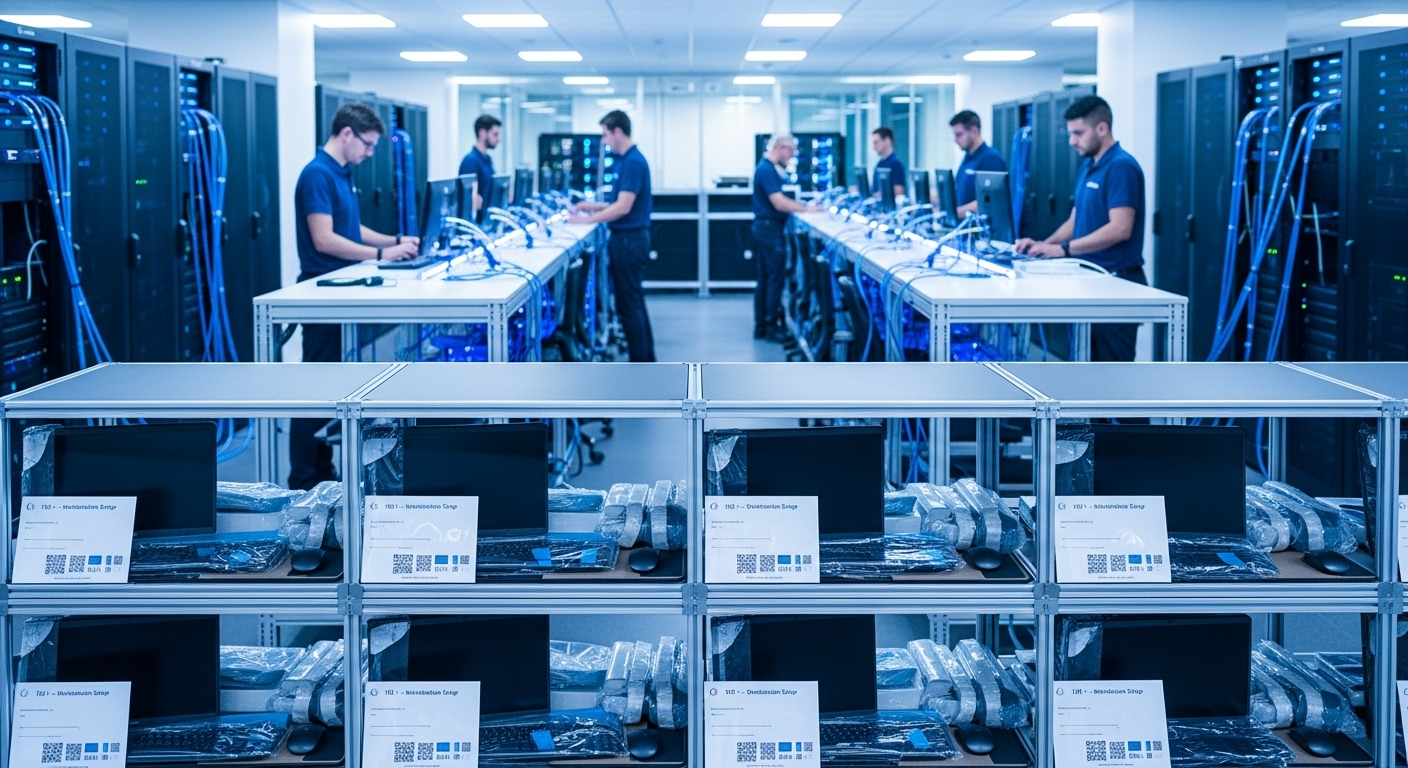Setting up the IT infrastructure for a new office is no longer just about plugging in computers and connecting to the internet. In today’s hybrid, cloud-driven world, it’s about architecting a digital nervous system that is secure, scalable, and supportive of modern workflows. A poorly planned IT setup can lead to crippling downtime, security vulnerabilities, and frustrated employees. Conversely, a well-executed strategy becomes a competitive advantage, enabling seamless collaboration and productivity from day one. Recent search trends highlight a growing need for integrated guides that bridge the gap between physical logistics, like cabling and hardware procurement, and complex digital architecture, including cloud services and cybersecurity. This playbook provides a definitive, step-by-step framework to navigate this complexity, guiding you through every critical phase—from initial strategic planning and physical installation to cloud integration and long-term maintenance—ensuring your new office is built on a resilient and future-proof technological foundation.
The strategic blueprint: Planning your IT infrastructure
Before a single cable is run or a purchase order is issued, the foundation of a successful IT setup is laid in meticulous planning. This strategic blueprint phase is about defining what your business needs from its technology, not just today but for the foreseeable future. Begin with a comprehensive needs assessment. This involves more than just counting heads; it requires understanding the specific roles within your organization, the software applications they depend on, and their data access requirements. Consider your growth projections for the next three to five years. Will your team double in size? Will you be expanding into data-intensive fields like video production or AI? The answers to these questions will dictate the scalability requirements for your network, storage, and processing power. Next, develop a detailed budget that differentiates between Capital Expenditures (CapEx)—one-time purchases like servers and workstations—and Operational Expenditures (OpEx)—recurring costs like software subscriptions, cloud services, and internet connectivity. It’s crucial to account for hidden costs such as software licensing renewals, support contracts, and potential installation fees. A common pitfall is underestimating the ongoing financial commitment required to maintain a healthy IT ecosystem. Finally, establish a clear project timeline with key milestones and assign responsibilities. This project plan should be a collaborative document, involving stakeholders from operations, finance, and HR to ensure the IT infrastructure aligns perfectly with the broader business objectives and move-in schedule.
Laying the foundation: Cabling and physical hardware
With a strategic plan in place, the next phase involves translating that blueprint into a physical reality. This starts with the literal backbone of your office network: structured cabling. Investing in high-quality cabling, such as Cat6a, is essential for future-proofing your office to handle increasing data demands and higher speeds. Work with your building manager or a professional installer to map out cable runs to every desk, conference room, and access point location. A critical component of this physical layer is the server room or IT closet. This space requires careful design considerations for power, cooling, and physical security. Ensure you have dedicated power circuits and an uninterruptible power supply (UPS) to protect critical equipment from outages. Proper ventilation or a dedicated cooling unit is non-negotiable to prevent hardware from overheating. When it comes to selecting hardware, create standardized builds for different employee roles. A developer will have different needs than a sales representative. Standardizing on a few models of laptops, monitors, and peripherals simplifies procurement, deployment, and ongoing support. The logistics of procurement are also key. Build relationships with reliable vendors and time your purchases to align with your project timeline, ensuring equipment arrives before it’s needed for installation but not so early that it sits idle or clutters the space during construction.
Building the network: Connectivity and security
Your physical hardware is useless without a robust, secure, and reliable network connecting it all. The first step is selecting an Internet Service Provider (ISP). For most businesses, a dedicated fiber connection is the gold standard for speed and reliability. It’s also wise to consider a secondary, redundant internet connection from a different provider to ensure business continuity in case of an outage. Inside the office, your core network hardware—the router, switches, and firewall—acts as the traffic cop for all your data. A business-grade firewall is your first and most critical line of defense against external threats. Network switches connect your devices, and it’s important to choose switches with enough ports and capacity (PoE for phones and cameras) to handle your current and future needs. Designing your wireless network is equally important, especially in a modern office where users expect seamless mobility. A professional Wi-Fi survey can help determine the optimal placement of wireless access points (WAPs) to ensure complete coverage and sufficient capacity, avoiding dead zones and bottlenecks. Foundational security must be baked in from the start. This includes configuring your firewall with strict access control lists (ACLs), setting up separate virtual LANs (VLANs) to segment traffic (e.g., keeping guest Wi-Fi separate from the corporate network), and establishing a secure Virtual Private Network (VPN) for employees who need to access company resources remotely. This creates a multi-layered defense that protects your digital assets from the ground up.
Embracing the cloud: Software, services, and data management
The modern office operates in the cloud. Your IT setup strategy must therefore have a strong focus on selecting, integrating, and managing cloud-based services. For core productivity, the primary decision is often between suites like Microsoft 365 and Google Workspace. The choice depends on your existing workflows, collaboration needs, and integration requirements with other business-critical applications. Beyond these suites, you will need to select a range of Software-as-a-Service (SaaS) tools for functions like CRM, accounting, and project management. Centralizing the management of these applications is key to controlling costs and data. The next critical decision is your approach to infrastructure. Will you maintain on-premise servers for specific applications or data, or will you adopt a cloud-first strategy using Infrastructure-as-a-Service (IaaS) providers like AWS, Azure, or Google Cloud? For many startups and small businesses, a cloud-first approach reduces upfront hardware costs and offers greater flexibility and scalability. Perhaps the most critical cloud-enabled function is your data backup and disaster recovery (DR) strategy. Relying on a single local backup is no longer sufficient. A robust strategy follows the 3-2-1 rule: three copies of your data, on two different media types, with one copy stored off-site, typically in the cloud. Cloud backup solutions can automate this process, ensuring that in the event of a hardware failure, cyberattack, or natural disaster, you can recover your critical business data quickly and minimize downtime.
The human element: User onboarding and device management
Technology is only effective if the people using it are properly equipped and supported. A streamlined user onboarding and device management process is crucial for productivity and security. The goal is to ensure that a new employee can be productive from their very first hour. This starts with creating standardized machine ‘images’ or setup scripts that automatically install all necessary software, configure settings, and apply security policies to a new laptop. This ensures consistency and dramatically reduces setup time. To manage the growing fleet of devices—including company-owned laptops, tablets, and employee-owned smartphones (BYOD)—a Mobile Device Management (MDM) or Unified Endpoint Management (UEM) solution is essential. These platforms allow your IT team to enforce security policies, such as mandatory screen locks and data encryption, deploy applications remotely, and, if a device is lost or stolen, wipe it of sensitive company data. The onboarding process itself should be a well-documented checklist. This includes creating user accounts across all necessary systems with the appropriate permissions (adhering to the principle of least privilege), providing initial training on key software and security practices, and ensuring the employee knows how to get IT support when they need it. A smooth onboarding experience not only boosts immediate productivity but also sets a positive tone for the employee’s entire tenure with the company.
Day two and beyond: Support, maintenance, and lifecycle management
Your IT setup isn’t complete once the office is open and everyone is logged in. The ‘Day Two’ operations are what keep the system running smoothly, securely, and efficiently over the long term. The first pillar of this is a responsive IT support system. Whether it’s an internal helpdesk, a managed service provider (MSP), or simply a clear ticketing system, employees need a reliable channel to resolve tech issues quickly. Frustration with IT support is a major drain on morale and productivity. The second pillar is proactive maintenance. This involves a regular schedule of patching and updating all software, from operating systems to applications, to protect against security vulnerabilities. It also includes monitoring network performance, server health, and backup success to identify and address potential problems before they cause downtime. Finally, a robust IT strategy must include asset lifecycle management. This means tracking every piece of hardware from procurement to disposal. Knowing the age, warranty status, and user assignment for every device helps in planning for future upgrades and replacements. When a piece of equipment reaches the end of its life, it’s critical to have a secure disposal process that ensures all sensitive data is permanently erased before the hardware is recycled or discarded. This ongoing cycle of support, maintenance, and management transforms your IT setup from a one-time project into a continuously optimized strategic asset for the business.
In conclusion, architecting the IT infrastructure for a new office is a multi-faceted endeavor that serves as the bedrock for your entire operation. This playbook demystifies the process by breaking it down into six logical and actionable stages: strategic planning, physical installation, network construction, cloud integration, user onboarding, and ongoing maintenance. By meticulously navigating each phase, from mapping out data cabling to defining a cloud backup strategy, you move beyond a merely functional setup to create a truly strategic asset. The key takeaway is that a successful IT launch is not a finish line but a starting line. The technology landscape evolves constantly, and the most resilient businesses are those that treat their IT infrastructure as a living system—one that requires continuous support, proactive maintenance, and strategic lifecycle management. Investing the time and resources to get it right from the beginning will pay dividends in enhanced productivity, stronger security, and the scalable capacity to support your company’s growth for years to come.





